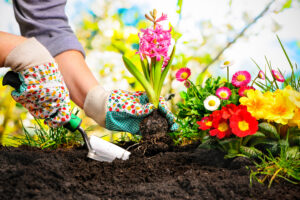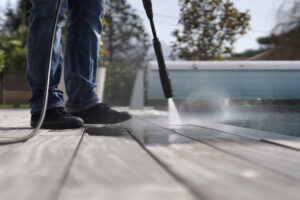Essential Home Maintenance Tasks for Every Season

*Updated February 18th, 2025
Your home works hard for you all year long, so giving it a little TLC each season is the best way to keep it in top shape. From scorching summers to freezing winters, every season brings unique challenges that can take a toll on your home if left unchecked. That’s why having a simple, seasonal home maintenance routine is key—it helps prevent small problems from turning into costly repairs, keeps your home running efficiently, and ensures everything stays safe and comfortable for you and your family.
The good news? Home maintenance doesn’t have to be overwhelming! By breaking it down into manageable tasks throughout the year, you can stay ahead of wear and tear without spending entire weekends tackling home projects. Whether it’s clearing out gutters in the fall, prepping your HVAC system before summer heatwaves, or winterizing pipes before freezing temps hit, a little seasonal upkeep goes a long way.
In this guide, we’ll walk you through essential home maintenance tasks for every season so you can protect your home, save money, and enjoy peace of mind year-round.

Spring Home Maintenance
1. Exterior Inspection and Cleaning
Roof Inspection and Repair
With the arrival of spring, it’s an opportune time to assess the condition of your roof. Look for signs of damage, such as missing shingles, leaks, or deteriorating flashing. Promptly addressing these issues can prevent water infiltration and subsequent interior damage. Arrange for necessary repairs or professional evaluation if needed.

Gutter Cleaning and Repair
Over the winter months, gutters can accumulate debris, causing blockages and potential water overflow. Clear out leaves, twigs, and other obstructions to ensure proper drainage. Additionally, examine the gutters for any signs of damage or sagging, and make repairs or replacements as necessary.
Window and Door Inspection
Inspect your windows and doors for weatherstripping damage or gaps that could lead to drafts and energy inefficiency. Address any issues by resealing or replacing damaged weatherstripping. Check for proper operation and make sure locks, latches, and hinges are in good working condition to enhance security and insulation.
2. Landscaping and Outdoor Areas
Lawn Care and Mowing
As the weather warms, your lawn begins to come back to life. Kick-start the growing season by giving your lawn proper care and attention.
Begin with raking to remove debris and thatch, allowing air and nutrients to reach the soil. Follow this with aeration to enhance water absorption. Once the lawn is prepared, establish a consistent mowing schedule, ensuring that you don’t cut more than one-third of the grass height at a time. Regular mowing promotes healthy growth and a lush, vibrant lawn.

Garden Preparation and Planting
Spring is the perfect time to breathe new life into your garden. Start by clearing away any dead plants, weeds, or debris from the previous season.
Prepare the soil by loosening it and adding compost or fertilizer to provide essential nutrients. Determine your garden’s layout and plan which plants, flowers, or vegetables you’d like to cultivate.
Early spring is ideal for planting cold-hardy vegetables and perennials, while waiting a bit later allows for warm-season crops. Remember to water and mulch newly planted areas to retain moisture and inhibit weed growth.
3. HVAC System Check
Air Conditioning Maintenance
With warmer days on the horizon, it’s essential to ensure your air conditioning system is in optimal working condition. Schedule a professional HVAC inspection to check for refrigerant levels, electrical connections, and overall system performance. Addressing any issues early can prevent breakdowns during peak cooling season and maintain a comfortable indoor environment.
Cleaning or Replacing Filters
Clean and efficient air filters are crucial for maintaining indoor air quality and system efficiency. Clean or replace your HVAC filters according to manufacturer recommendations. This simple task helps prevent dust and allergen buildup and ensures proper airflow throughout your home.
4. Indoor Tasks
Deep Cleaning and Decluttering
Spring cleaning goes beyond routine tidying; it involves a thorough and revitalizing cleanse of your living spaces. Take the opportunity to deep clean carpets, upholstery, and curtains. Dust and sanitize surfaces, including baseboards, light fixtures, and ceiling fans. Declutter by organizing closets, cabinets, and storage areas. A refreshed and organized interior promotes a healthier and more pleasant living environment.
Summer Home Maintenance
1. Exterior Inspection and Cleaning

Deck and Patio Maintenance
With the arrival of summer, your outdoor living spaces become focal points for relaxation and entertainment. Properly maintaining your deck and patio ensures their longevity and safety. Inspect the deck for signs of rot, warping, or loose boards, and address any issues promptly. Clean and pressure wash the surfaces to remove dirt, mold, and stains. Apply a protective sealant to preserve the wood’s integrity. Similarly, assess your patio for cracks or uneven areas, and consider resealing if necessary.
Pool and Water Feature Maintenance
If you’re fortunate to have a pool or water features, summer is the season they shine. Regular pool maintenance is essential to ensure water clarity, balance, and safety. Test and adjust water chemistry, clean debris from the pool surface, and inspect filters and pumps. For water features, clean out debris and ensure proper water circulation. Regular upkeep guarantees a refreshing and inviting outdoor oasis for you and your family.
2. Pest Control
Inspection and Prevention
As the temperatures rise, so does the activity of various pests seeking refuge indoors. Conduct a thorough inspection of your home’s exterior, paying attention to potential entry points such as gaps, cracks, and openings around doors, windows, and utility lines. Seal these entry points to prevent pests from infiltrating your living spaces. Trim back vegetation near the house, as overgrown plants can provide hiding spots and pathways for pests. Additionally, consider using pest-resistant landscaping and employing natural or chemical pest control measures to create a pest-free environment for your family to enjoy during the summer months.
3. Energy Efficiency
Sealing Gaps and Cracks
Enhancing your home’s energy efficiency is a year-round endeavor, and summer offers an opportunity to address any gaps or cracks that may have developed over time.
Inspect doors, windows, and areas where different building materials meet for signs of air leaks. Seal these gaps using weatherstripping, caulking, or expanding foam. By preventing cool air from escaping and hot air from infiltrating, you’ll create a more comfortable indoor environment and reduce your cooling costs.
Ensuring Proper Insulation
Adequate insulation is a key component of maintaining energy efficiency. Check your home’s insulation, especially in the attic and walls, to ensure it’s in good condition and providing the necessary thermal barrier.
Proper insulation prevents temperature transfer and reduces the workload on your cooling system. If needed, consider adding or upgrading insulation to maintain a consistent indoor temperature and optimize your energy consumption during the summer months.
Fall Home Maintenance
1. Exterior Preparation
Roof and Gutter Cleaning
As the leaves begin to fall, it’s essential to clear your roof and gutters of debris to prevent clogs and water damage. Clean out accumulated leaves, twigs, and other debris from gutters and downspouts. Consider installing gutter guards to reduce future buildup. Additionally, inspect your roof for any loose or damaged shingles and address repairs promptly to prevent leaks during the upcoming rainy seasons.
Driveway and Walkway Maintenance
Fall maintenance extends beyond the house to your exterior walkways and driveway. Check for cracks, gaps, or uneven surfaces that may have developed over time. Repair any damage to ensure safe and smooth passage, especially as the weather gets colder and icy conditions become a concern. Applying a sealant or resurfacing these areas can help protect them from winter weather and prolong their lifespan.
2. Yard Cleanup

Leaf Removal and Lawn Care
As trees shed their leaves, keeping your yard free from leaf accumulation becomes crucial. Rake and collect fallen leaves to prevent them from suffocating the grass and creating a breeding ground for pests and diseases. This is also an ideal time to mow your lawn one final time before winter sets in, ensuring a neat appearance and promoting healthy growth in the following spring.
Garden Bed Preparation
Preparing your garden beds for winter is an essential step in maintaining a thriving landscape. Clear out spent annuals and trim back perennial plants. Mulch the soil to insulate and protect plant roots from freezing temperatures. By tending to your garden beds now, you lay the groundwork for vibrant and resilient plants when spring arrives.
Heating System Check
As the temperature drops, it’s crucial to ensure that your heating system is in optimal working condition. Schedule a professional inspection and maintenance for your furnace or heating system. Change air filters to promote efficient airflow and clean ducts to improve indoor air quality. This proactive approach ensures that your home remains warm and comfortable during the colder months.
3. Heating System Check
Furnace Maintenance
As the temperature begins to drop, ensuring your furnace is operating efficiently is paramount. Schedule a professional maintenance service to clean and inspect your furnace. This includes checking for wear and tear, replacing filters, and verifying proper ignition and fuel combustion. A well-maintained furnace not only keeps your home warm but also contributes to energy savings and prevents potential safety hazards.
Chimney Inspection and Cleaning
For homes with chimneys, fall is an opportune time to have them inspected and cleaned. Over time, creosote buildup can occur, which poses a fire hazard. A professional chimney sweep can remove creosote, nests, and debris, ensuring proper ventilation and safe operation. This step is essential to maintain both the efficiency and safety of your heating system.
4. Indoor Tasks
Winterizing Windows and Doors
Preventing heat loss through windows and doors is vital for maintaining a cozy indoor environment during winter. Check for drafts around windows and doors, and apply weatherstripping or caulking as needed to seal gaps.
Consider installing window insulation film to add an extra layer of insulation. For doors, install door sweeps to prevent cold air from entering. These measures help conserve energy and keep your home comfortably warm.

Winter Home Maintenance
1. Winterizing Exterior
Outdoor Plumbing Protection
As temperatures drop, preventing frozen pipes is crucial to avoid costly water damage. Drain outdoor faucets and irrigation systems to prevent freezing and bursting. Insulate exposed pipes with pipe sleeves or heat tape, and consider using insulating covers for outdoor spigots. Taking these precautions safeguards your plumbing system from winter’s chill.
Winterizing Gardens and Landscaping
Preparing your outdoor plants and landscaping for winter helps ensure their survival and vitality come spring. Trim back perennials, remove dead foliage, and add a layer of mulch to insulate plant roots. Protect delicate plants with burlap or other coverings. These steps shield your garden and landscaping from harsh winter conditions.
2. Indoor Comfort and Safety
Heating System Maintenance
Maintaining your heating system’s functionality during winter is paramount. Schedule a professional inspection and tune-up for your furnace or heating system. Clean or replace filters to ensure efficient airflow and optimal heating performance. Proper maintenance enhances indoor comfort and energy efficiency.
Carbon Monoxide and Smoke Detector Checks
With heaters and fireplaces in frequent use, it’s essential to ensure your carbon monoxide and smoke detectors are working correctly. Test alarms, replace batteries, and vacuum out dust to keep these life-saving devices in optimal condition, providing early warnings in case of emergencies.
3. Energy Efficiency
Insulating Pipes and Water Heaters
Insulating exposed pipes helps prevent freezing and maintains consistent hot water supply. Install pipe insulation sleeves to protect against temperature drops. For added energy efficiency, insulate your water heater to reduce heat loss and energy consumption, ultimately leading to cost savings.

4. Holiday Lighting and Decor
Safety and Installation Tips
Brightening your home with holiday lights and decorations is a joyful tradition. However, safety remains paramount. Use outdoor-rated extension cords and ensure all lighting is properly grounded. Avoid overloading circuits, and never leave lights on unattended. Safely secure decorations and be mindful of potential fire hazards, ensuring a festive and secure holiday season.
Year-Round Maintenance
1. Cleaning Gutters
Keeping your gutters clean and free from debris is a year-round necessity to ensure proper water drainage. Regularly clear out leaves, twigs, and dirt that can clog gutters and downspouts. This preventive measure helps prevent water damage to your roof, foundation, and landscaping.
2. Checking for Water Leaks
Consistently inspect your home for water leaks, as even minor leaks can lead to significant damage over time. Check for signs of water stains, mold growth, or dampness in ceilings, walls, and basements. Promptly addressing leaks prevents structural deterioration and potential health hazards.

3. Regular HVAC Maintenance
Maintaining your heating, ventilation, and air conditioning (HVAC) system ensures efficient operation and indoor comfort year-round. Schedule regular professional maintenance, including cleaning coils, lubricating parts, and checking refrigerant levels. Proper HVAC maintenance prolongs the system’s lifespan and reduces energy consumption.
4. Changing Filters
Regularly changing air filters is a simple yet impactful maintenance task. Clean filters promote better indoor air quality, enhance HVAC system efficiency, and prevent dust buildup in your home. Follow the manufacturer’s recommendations for filter replacement frequency based on your system and household needs.
5. Testing and Resetting Safety Devices
Safety devices such as smoke detectors, carbon monoxide detectors, and security alarms play a crucial role in safeguarding your home and family. Test these devices monthly and replace batteries annually. Familiarize yourself with reset procedures and ensure they’re functioning correctly to maintain a secure living environment.
Final Thoughts

Anna has over six years of experience in the home services and journalism industries and serves as the Content Manager at MyHomePros.com, specializing in making complex home improvement topics like HVAC, roofing, and plumbing accessible to all. With a bachelor’s degree in journalism from Auburn University, she excels in crafting localized, comprehensive guides that cater to homeowners’ unique needs. Living on both coasts of the United States has equipped her with a distinctive perspective, fueling her passion for turning any house into a cherished home through informed, personalized decision-making.








